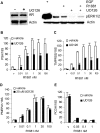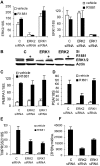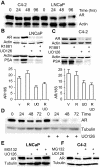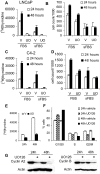Target gene-specific regulation of androgen receptor activity by p42/p44 mitogen-activated protein kinase
- PMID: 18787043
- PMCID: PMC2582542
- DOI: 10.1210/me.2007-0481
Target gene-specific regulation of androgen receptor activity by p42/p44 mitogen-activated protein kinase
Abstract
Evidence that the androgen receptor (AR) is not only important in androgen-dependent prostate cancer, but also continues to play a role in tumors that become resistant to androgen deprivation therapies, highlights the need to find alternate means to block AR activity. AR, a hormone-activated transcription factor, and its coactivators are phosphoproteins. Thus, we sought to determine whether inhibition of specific cell signaling pathways would reduce AR function. We found that short-term inhibition of p42/p44 MAPK activity either by a MAPK kinase inhibitor, U0126, or by depletion of kinase with small interfering RNA caused target gene-specific reductions in AR activity. AR enhances histone H3 acetylation of target genes that are sensitive to U0126 including prostate-specific antigen and TMPRSS2, but does not increase histone H3 acetylation of the U0126-resistant PMEPA1 gene. Thus, although AR induces transcription of many target genes, the molecular changes induced by AR at the chromatin level are target gene specific. Long-term treatment (24-48 h) with U0126 causes a G1 cell cycle arrest and reduces AR expression both through a decrease in AR mRNA and a reduction in AR protein stability. Thus, treatments that reduce p42/p44 MAPK activity in prostate cancer have the potential to reduce AR activity through a reduction in expression levels as well as by target gene-selective inhibition of AR function.
Figures







Similar articles
-
The requirement for p42/p44 MAPK activity in progesterone receptor-mediated gene regulation is target gene-specific.Steroids. 2013 Jun;78(6):542-7. doi: 10.1016/j.steroids.2012.12.014. Epub 2013 Feb 1. Steroids. 2013. PMID: 23380370 Free PMC article.
-
Transcriptional regulation of VCAM-1 expression by tumor necrosis factor-alpha in human tracheal smooth muscle cells: involvement of MAPKs, NF-kappaB, p300, and histone acetylation.J Cell Physiol. 2006 Apr;207(1):174-86. doi: 10.1002/jcp.20549. J Cell Physiol. 2006. PMID: 16288471
-
A novel androgen receptor-binding element modulates Cdc6 transcription in prostate cancer cells during cell-cycle progression.Nucleic Acids Res. 2009 Aug;37(14):4826-38. doi: 10.1093/nar/gkp510. Epub 2009 Jun 11. Nucleic Acids Res. 2009. PMID: 19520769 Free PMC article.
-
The role of the androgen receptor in the development of prostatic hyperplasia and prostate cancer.Mol Cell Biochem. 2003 Nov;253(1-2):89-101. doi: 10.1023/a:1026057402945. Mol Cell Biochem. 2003. PMID: 14619959 Review.
-
p42/p44 Mitogen-activated protein kinase signal transduction pathway: a novel target for the treatment of hormone-resistant prostate cancer?Ann N Y Acad Sci. 2004 Dec;1030:243-52. doi: 10.1196/annals.1329.030. Ann N Y Acad Sci. 2004. PMID: 15659803 Review.
Cited by
-
Androgen receptor and its splice variant, AR-V7, differentially regulate FOXA1 sensitive genes in LNCaP prostate cancer cells.Int J Biochem Cell Biol. 2014 Sep;54:49-59. doi: 10.1016/j.biocel.2014.06.013. Epub 2014 Jul 4. Int J Biochem Cell Biol. 2014. PMID: 25008967 Free PMC article.
-
Decreased expression and androgen regulation of the tumor suppressor gene INPP4B in prostate cancer.Cancer Res. 2011 Jan 15;71(2):572-82. doi: 10.1158/0008-5472.CAN-10-2314. Epub 2011 Jan 11. Cancer Res. 2011. PMID: 21224358 Free PMC article.
-
Effects of sorafenib on C-terminally truncated androgen receptor variants in human prostate cancer cells.Int J Mol Sci. 2012;13(9):11530-11542. doi: 10.3390/ijms130911530. Epub 2012 Sep 14. Int J Mol Sci. 2012. PMID: 23109869 Free PMC article.
-
RhoGDIα downregulates androgen receptor signaling in prostate cancer cells.Prostate. 2013 Nov;73(15):1614-22. doi: 10.1002/pros.22615. Epub 2013 Aug 6. Prostate. 2013. PMID: 23922223 Free PMC article.
-
Genomic collaboration of estrogen receptor alpha and extracellular signal-regulated kinase 2 in regulating gene and proliferation programs.Mol Cell Biol. 2011 Jan;31(1):226-36. doi: 10.1128/MCB.00821-10. Epub 2010 Oct 18. Mol Cell Biol. 2011. PMID: 20956553 Free PMC article.
References
-
- Tomlins SA, Rhodes DR, Perner S, Dhanasekaran SM, Mehra R, Sun XW, Varambally S, Cao X, Tchinda J, Kuefer R, Lee C, Montie JE, Shah RB, Pienta KJ, Rubin MA, Chinnaiyan AM 2005 Recurrent fusion of TMPRSS2 and ETS transcription factor genes in prostate cancer. Science 310:644–648 - PubMed
-
- Chen CD, Welsbie DS, Tran C, Baek SH, Chen R, Vessella R, Rosenfeld MG, Sawyers CL 2004 Molecular determinants of resistance to antiandrogen therapy. Nat Med 10:33–39 - PubMed
-
- Zegarra-Moro OL, Schmidt LJ, Huang H, Tindall DJ 2002 Disruption of androgen receptor function inhibits proliferation of androgen-refractory prostate cancer cells. Cancer Res 62:1008–1013 - PubMed
-
- Agoulnik IU, Vaid A, Bingman 3rd WE, Erdeme H, Frolov A, Smith CL, Ayala G, Ittmann MM, Weigel NL 2005 Role of SRC-1 in the promotion of prostate cancer cell growth and tumor progression. Cancer Res 65:7959–7967 - PubMed
-
- Agoulnik IU, Weigel NL 2006 Androgen receptor action in hormone-dependent and recurrent prostate cancer. J Cell Biochem 99:362–372 - PubMed
Publication types
MeSH terms
Substances
Grants and funding
LinkOut - more resources
Full Text Sources
Other Literature Sources
Research Materials

